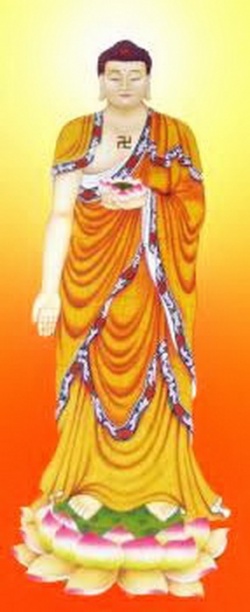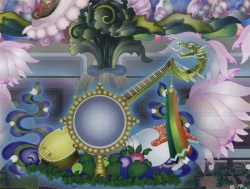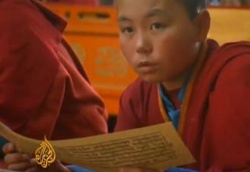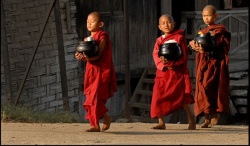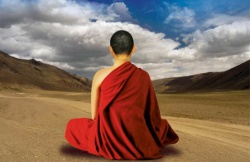Theravada
Theravada (Pāli: थेरवाद theravāda (cf Sanskrit: स्थविरवाद sthaviravāda); literally, "the Teaching of the Elders", or "the Ancient Teaching") is the oldest surviving Buddhist school. It is relatively conservative, and generally closest to early Buddhism, and for many centuries has been the predominant religion of Sri Lanka (about 70% of the population) and most of continental Southeast Asia (Cambodia, Laos, Burma, Thailand). It is also practised by minorities in parts of southwest China (by the Shan and Tai ethnic groups), Vietnam (by the Khmer Krom), Bangladesh (by the ethnic groups of Baruas, Chakma, and Magh), Malaysia, Philippines and Indonesia, whilst recently gaining popularity in Singapore and Australia. Today Theravada Buddhists number about 250 million worldwide, and in recent decades Theravada has begun to take root in the West and in the Buddhist revival in India.
History
The Theravāda school is ultimately derived from the Vibhajjavada (or 'doctrine of analysis') grouping which was a continuation of the older Sthavira (or 'teaching of the Elders') group at the time of the Third Buddhist Council around 250 BCE, during the reign of Emperor Asoka in India. Vibhajjavadins saw themselves as the continuation of orthodox Sthaviras and after the Third Council continued to refer to their school as the Sthaviras/Theras ('The Elders'), their doctrines were probably similar to the older Sthaviras but were not completely identical. After the Third Council geographical distance led to the Vibhajjavādins gradually evolving into four groups: the Mahīśāsaka, Kāśyapīya, Dharmaguptaka and the Tāmraparnīya. The Theravada is descended from the Tāmraparnīya, which means 'the Sri Lankan lineage'. Some sources claim that only the Theravada actually evolved directly from the Vibhajjavādins.
Main Doctrines
The main doctrines of Theravada are from the teachings found in the Pali Canon of early Buddhism. These include the Four Noble Truths, The Noble Eightfold Middle Path, and the Hindrances to Enlightenment. There is little to no use of worship in Theravada and emphasis is on mental development through meditation.
Levels of Attainment
A Buddha is someone who is fully enlightened. A person who is fully enlightened, but not the Buddha of our time, is called an Arahant in Pali. Such a person has eradicated all ten hindrances to enlightenment:
- The belief in a permanent personality, ego
- Doubt, extreme skepticism
- Attachment to rites, rituals, and ceremonies
- Attachment to sense desires
- Ill-will, anger
- Craving for existence in the Form world (heavenly realms)
- Craving for existence in the Formless world (heavenly realms)
- Conceit
- Restlessness
- Ignorance
An Anagami (non-returner) has completely eradicated the first five hindrances and never returns to earth or any other world system (planet, solar system). Such a person is re-born to a heavenly realm and attains enlightenment from there.
A Sakadagami (once returner) has eradicated the first three hindrances and greatly weakened the fourth and fifth; attachment to sense desires and ill-will. Such a person will be re-born to either the human or heavenly realm and will attain enlightenment there.
A Sotapanna (stream entrant) has eradicated the first three hindrances and will be re-born no more than seven more times and re-birth will either be as a human or a deva in a heavenly realm.
Different forms Theravada takes
Theravada Buddhism has taken four distinctive forms in the West and around the world, in modern times:
A. The Secular Buddhist Society Model. This is concerned with the intense study of the Dhamma in its original formulation as given in the Pali Canon, the development of norms of living in substantial conformity of the requirements of the Dhamma, and the encouragement of the observance of the Dhamma generally.
B. The Original London Vihara Model. This model encompasses the objectives of the secular societies, but places greater emphasis on the necessity to accommodate ordained monks to expound the Dhamma. In its interpretation of the Canon it tends to place greater emphasis on Buddhaghosa's exegesis whereas the secular societies tend to go the original Canon itself.
C. The Lankarama Model. This is the ethnic Buddhist Model par excellence. Its main objective appears to be to cater to the spiritual needs of expatriate groups using the particular national models of Buddhism as practiced in their home countries without any consideration of its relevance to the universality of the Buddha's teaching or the external conditions in the host country.
D. The Meditation Centre Model. Here the Buddhist Institution is transformed into a centre for "meditation" under the guidance of a self-proclaimed "teacher". The meditation practiced is a simplified form of the first foundation of satipatthana ignoring all the preconditions which the Buddha was careful to lay down for the correct practice of this technique of mindfulness.
Dr. Gunasekara argues that models A and B are appropriate modes in following the teachings of Buddha whereas models C and D are departures from the teachings[1].
Variations A and sometimes B and D tends to be a Modern Theravada which focuses on the Pali Canon and acknowledges that some of the suttas are not meant to be taken too literally. Variation B and sometimes C are a Classical Theravada which tends to use the literal word of the writings in the Pali Canon and the Commentaries.
- The domain name http://www.theravadabuddhism.org/ redirects to this page.
See also
see also: Theravāda
References
Footnotes
- ↑ Dr. V. A. Gunasekara. "Ethnic Buddhism and Other Obstacles to the Dhamma in the West". http://buddhanet.net/bsq14.htm#sec3. Retrieved 5 Oct 2008.
- The Complete Book of Buddha's Lists -- Explained. David N. Snyder, Ph.D., 2006.
- http://www.thedhamma.com/
